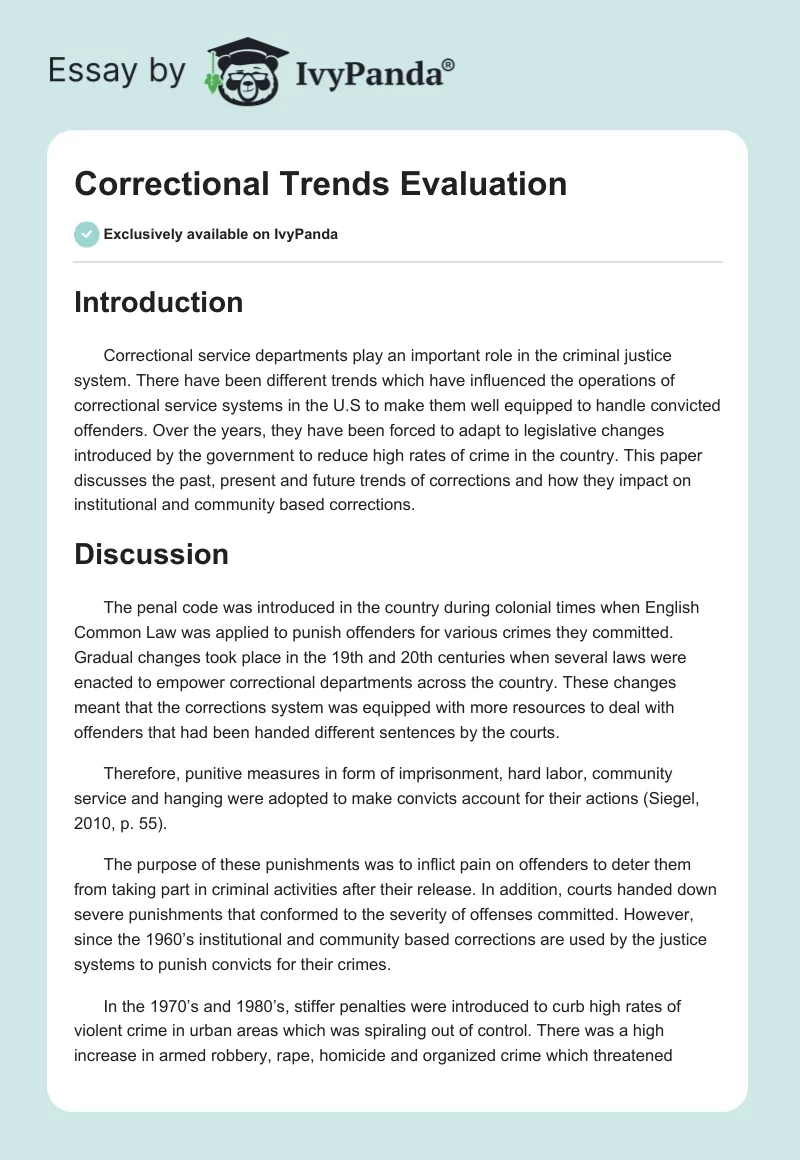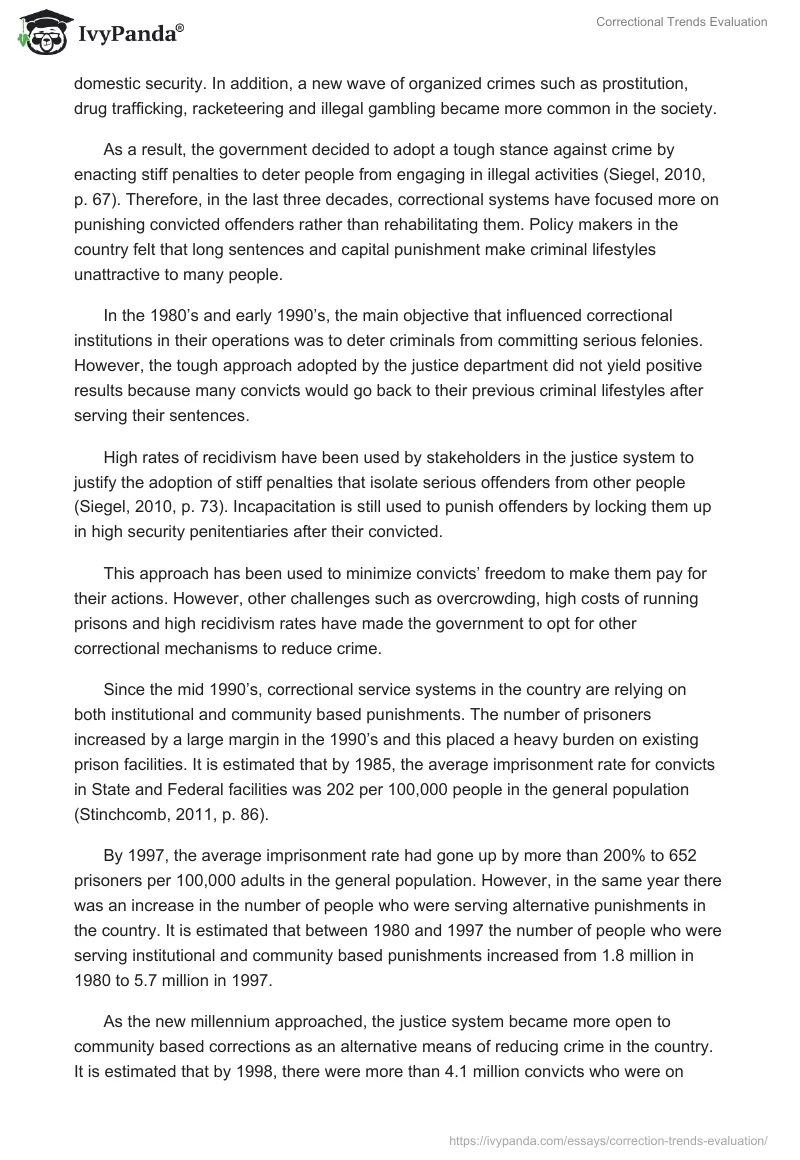Introduction
Correctional service departments play an important role in the criminal justice system. There have been different trends which have influenced the operations of correctional service systems in the U.S to make them well equipped to handle convicted offenders. Over the years, they have been forced to adapt to legislative changes introduced by the government to reduce high rates of crime in the country. This paper discusses the past, present and future trends of corrections and how they impact on institutional and community based corrections.
Discussion
The penal code was introduced in the country during colonial times when English Common Law was applied to punish offenders for various crimes they committed. Gradual changes took place in the 19th and 20th centuries when several laws were enacted to empower correctional departments across the country. These changes meant that the corrections system was equipped with more resources to deal with offenders that had been handed different sentences by the courts.
Therefore, punitive measures in form of imprisonment, hard labor, community service and hanging were adopted to make convicts account for their actions (Siegel, 2010, p. 55).
The purpose of these punishments was to inflict pain on offenders to deter them from taking part in criminal activities after their release. In addition, courts handed down severe punishments that conformed to the severity of offenses committed. However, since the 1960’s institutional and community based corrections are used by the justice systems to punish convicts for their crimes.
In the 1970’s and 1980’s, stiffer penalties were introduced to curb high rates of violent crime in urban areas which was spiraling out of control. There was a high increase in armed robbery, rape, homicide and organized crime which threatened domestic security. In addition, a new wave of organized crimes such as prostitution, drug trafficking, racketeering and illegal gambling became more common in the society.
As a result, the government decided to adopt a tough stance against crime by enacting stiff penalties to deter people from engaging in illegal activities (Siegel, 2010, p. 67). Therefore, in the last three decades, correctional systems have focused more on punishing convicted offenders rather than rehabilitating them. Policy makers in the country felt that long sentences and capital punishment make criminal lifestyles unattractive to many people.
In the 1980’s and early 1990’s, the main objective that influenced correctional institutions in their operations was to deter criminals from committing serious felonies. However, the tough approach adopted by the justice department did not yield positive results because many convicts would go back to their previous criminal lifestyles after serving their sentences.
High rates of recidivism have been used by stakeholders in the justice system to justify the adoption of stiff penalties that isolate serious offenders from other people (Siegel, 2010, p. 73). Incapacitation is still used to punish offenders by locking them up in high security penitentiaries after their convicted.
This approach has been used to minimize convicts’ freedom to make them pay for their actions. However, other challenges such as overcrowding, high costs of running prisons and high recidivism rates have made the government to opt for other correctional mechanisms to reduce crime.
Since the mid 1990’s, correctional service systems in the country are relying on both institutional and community based punishments. The number of prisoners increased by a large margin in the 1990’s and this placed a heavy burden on existing prison facilities. It is estimated that by 1985, the average imprisonment rate for convicts in State and Federal facilities was 202 per 100,000 people in the general population (Stinchcomb, 2011, p. 86).
By 1997, the average imprisonment rate had gone up by more than 200% to 652 prisoners per 100,000 adults in the general population. However, in the same year there was an increase in the number of people who were serving alternative punishments in the country. It is estimated that between 1980 and 1997 the number of people who were serving institutional and community based punishments increased from 1.8 million in 1980 to 5.7 million in 1997.
As the new millennium approached, the justice system became more open to community based corrections as an alternative means of reducing crime in the country. It is estimated that by 1998, there were more than 4.1 million convicts who were on probation and parole. However, parole and probation officers face a lot of challenges which make it difficult for them to monitor convicts properly. In some instances, convicts are required to comply with unrealistic conditions which make it difficult for them to fit in normal societies.
Some convicts who are released after serving long prison terms find it difficult to stay away from crime because they are discriminated against by employers (Stinchcomb, 2011, p. 91).
This is a serious challenge that needs to be addressed to ensure ex convicts are not tempted to engage in crime after finishing their sentences. In some jurisdictions, parole and probation officers supervise many offenders due to staffing shortages. As a result, this is a weakness which is exploited by some convicts to violate legal conditions they are required to comply with.
In the future, correctional service departments need to use evidence based approaches to deal with various challenges they face in their operations. For instance, African American and Hispanic males have a higher risk of getting convicted compared to whites and Asians. Correctional service departments need to partner with community based organizations to come up with programs that discourage young people living in poor neighborhoods from engaging in crime.
Juvenile convicts also need to be treated with care to ensure they are not incarcerated in the same facilities with adult convicts. Studies have shown that underage convicts who are housed together with adult prisoners are likely to commit more serious crimes in future (Stinchcomb, 2011, p. 107). Community based corrections need to be strengthened to discourage people from engaging in crime.
For instance, fines, withdrawals of driving licenses and community service are some of the community based approaches that have reduced traffic offenses in the country. In addition, more correctional service professionals acknowledge that community based approaches are less costly compared to institutional corrections.
In conclusion, correctional services in the country need to be improved to reduce high rates of recidivism. Incarceration needs to be combined with probations, parole and community based approaches to reduce costs incurred in running prisons.
All stakeholders in the corrections system need to come up with new sentencing codes that conform to existing social conditions. Incapacitation should only be used to punish offenders who are not willing to reform to ensure they do not endanger the wellbeing of other law abiding members of the society. Probation and parole systems should adopt new policies to make them more effective in dealing with convicts who constantly violate legal conditions.
References
Siegel, L. (2010). Essentials of criminal justice. Mason, OH: Cengage Learning.
Stinchcomb, J. B (2011). Corrections: Foundations for the future. New York, NY: Taylor & Francis.


